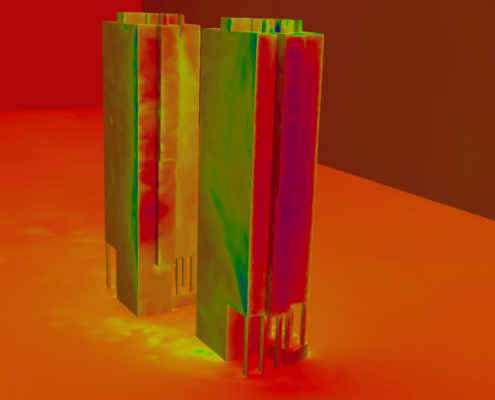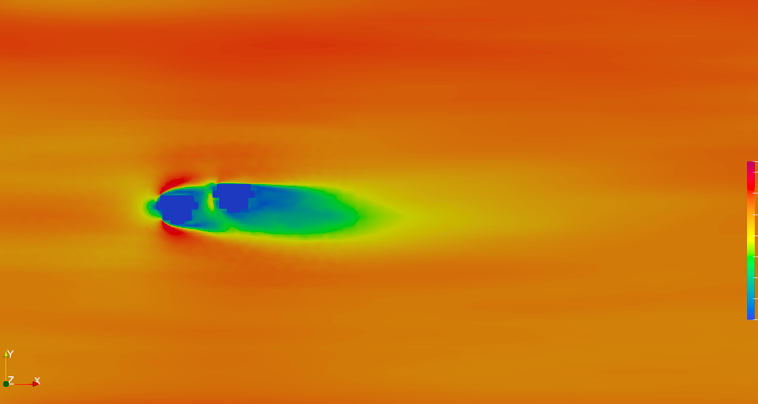Atis Degro on the untapped potential of the supercomputer – construction
The design of tall buildings must take into account the effects of wind. Currently, this is most often done using wind tunnels. The development of numerical methods and the increasing availability of supercomputers have meant that wind tunnel simulations are no longer the cheapest and fastest way to get results. Encouraging the construction industry to try out the Latvian supercomputer, Riga Technical University scientist Dr. sc. Ing. Atis Degro has created a wind flow simulation demo-case, taking as an example the well-known Philosophers’ High Buildings in Riga, which can also be seen from the window of RTU.
How did you come up with the idea to try a supercomputer for wind simulations?
I have been more or less doing wind flow simulations for the last 10 years. Wind flow simulations are a numerical process and require a lot of computer resources, so using a supercomputer for these simulations is natural. I am involved in the EuroCC Latvia project. Together with my colleagues, we have been thinking about how to tell the various representatives of the Latvian industry about the vast possibilities of our supercomputer. I came up with the idea of creating a demo-case with wind flow simulation that could be used in construction.
My aim with this demo-case was to show how accessible the supercomputer really is for such simulations.
The use of supercomputers in the construction process is currently not common practice, as until recently the availability and cost of supercomputing resources far outweighed the potential benefits.
These simulations are not as expensive as they used to be. Historically, wind simulations were typically used by industries with more financial resources. More accurate calculations mean big savings, e.g. in aviation, military. Now the resources of the supercomputer are much more accessible and we encourage other industries to use them too.
It should be added that I created the demo-case when the Philosopher’s House was already built. The simulation I did of wind flows is just an example to show that it can be done.
How would you explain what a supercomputer is to someone who doesn’t know?
The name says it all, it is a “super” computer. And in this case, “super” means significantly more powerful. Like any technology, supercomputers are evolving rapidly.
What was a supercomputer 10 years ago might now be a home computer. What was a supercomputer 20 years ago could be someone’s mobile phone today. Technology is constantly evolving.
Thanks to these developments, the supercomputer has become much more accessible to different industries, small and medium-sized enterprises, scientists and people whose work involves large amounts of data on a daily basis. In fact, it is difficult to put the potential customer base of a supercomputer into a narrow frame, as the possibilities for using a supercomputer today are very, very wide.
Why did you want to address the construction industry with your demo-case example?
Mainly because it is familiar to me. I have worked in it myself for several years and therefore know exactly where in the design process such computing resources could be useful. In the vast majority of construction projects, the use of a supercomputer may not really be necessary at all. However, we are also increasingly seeing non-standard buildings in Latvia – high-rise buildings, stadiums, concert halls – projects where the impact of wind loads can be very significant.
With this demo-case, I want to address the construction industry and show that supercomputing is an affordable option and worth considering when starting a new project.
Remember the first time you worked on a supercomputer? Were there any surprises in terms of using it?
The biggest surprise was how unsurprised I was. If you have worked with Linux and used the command line, using a supercomputer will not be surprising. It is different if one has only Windows experience, but even then getting started with a supercomputer is not a difficult process. More and more tools are being offered that allow you to use the supercomputer without having to change your routine, with calculations being automatically transferred to the supercomputer instead of having to do them on your workstation.
Do you use the supercomputer for your daily research?
Yes, because there is a necessity from time to time.
How would you describe which sectors of Latvian companies would benefit from the use of a supercomputer?
Construction is just one sector. Maybe even one of the smallest because, as I mentioned, in construction it is useful to model wind flows in non-standard projects. For example, the Mezaparks stage, I was not involved in the project and I don’t know exactly what structures were used, but it is very likely that in the design of the stage cover, wind flow simulation would have been useful to determine the loads. Maybe even that was done, it would be up to the designers.
There are many other sectors that those working in the industries themselves do not even think about. For example, the food industry. Latvia’s municipalities. For example, a new production plant is planned in a municipality. Residents may worry about how the new plant will affect their daily lives, whether they will smell something or whether there will be pollution. All this can be simulated and tested.
You can read more about the different demo-cases created in the EuroCC-Latvia project here.
Kintija Bulava, EuroCC-Latvija.





